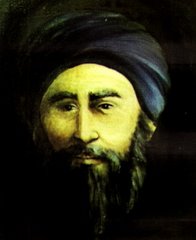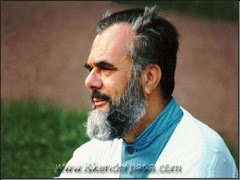
There is Islam. And then there is Indian folk Islam.
Indian folk Islam is a secular faith. Secular in the sense that Indians of all faiths participate. It is practised at the mazhaar (also known as the dargah), the tomb or shrine of a wali (saint).
The saints are believed to provide faiz (spiritual radiation) which benefits all who visit the saint's grave. Perhaps India's most famous and revered saint is Shaykh Muinuddin Chishti, whose tomb is located in Ajmer. At the bottom of this blog page, you will find a video slide-show of various scenes of the tomb of Shaykh Chishti. Accompanying that video is a song performed by India's musical maestro Allah-Rakka Rahman in honour of the saint.
Each year, My family has received letters from one Moallam Syed Azizur Rahman Burraqui, who claims to have some link to the saint's tomb. The letter announces the Urs Mubarak, a special function that runs for a number of days and is devoted to prayers and the performance of qawwali devotional songs sung in Urdu in praise of God, the Prophet Muhammad and the Shaykh.
This year, the Urs of Shaykh Muinuddin Chishti (referred to in Mr Burraqui's letter using a plethora of labels - "Hazrat Khwaja Moinuddin Chisty Sanjari Summa Ajmer, honoured as Ata-e-Rasool") was held on 5-13 July 2008. Excerpts from the letter are worth reproducing if only for the rather over-the-top language used in religious and devotional correspondence and the mixture of English and Urdu-ised Arabic present (not to mention grammatical and spelling errors).
Dear Devotee,
Hazrat Khwaja Moinuddin Chisty Sanjari Summa Ajmer (R.A.) honoured as Ata-e-Rasool (S.A.W.) was born early in the morning on Monday the 14th Rajan of 535 Hijri, He served and remained under the training of Shaikh O. Murshid Tariqat Hazrat Khwaja Usman Harooni (R.A.) for the period of complete twenty years. He learned Elm-E-Batin and how to control consciousness and heartfelt desire. He came to Ajmer India via Macca Mukarrama, Madina Munawarra, Baghdad Sharif, Asfahan, Multan, Lahore and Delhi. He selected soil of Ajmer for place of rest permanently and spent hos whole life for preaching of Doctrines of Islam through love and peace and serving human being. He left this temporary world at the age of 97the on Friday the 6th Rajab of 633 Hijri. Since his demise on this auspicious day an annual Urs Mubarak is celebrated every year as a mark of reverence and homage.
That's the biographical stuff out of the way. Now time for some good old fashioned Indian hospitality ...
I am giving to you an auspicious news that the Urs Mubarak of Hazrat Khwaja Moinuddin Hassan Sanjary Chishti Summa Ajmeri Known as Ghareeb Nawaz (R.A.) will be held from 1st Rajab to 9th Rajab.i.e. 5th July to 13 July 2008.If even after such a gracious invitation you insist on doing a no-show, you can always obtain some faiz of your own. At a price, of course.
If you or any of your relatives and friends intend to visit the Ajmer to participate in Holy Urs Mubarak, please inform me before your departure about your complete programme by my Telephone No. [number] #Mobile [number], so that I can make all necessary arrangement for your lodging and boarding at my Guest House just opposite the main Gate of Dargah Sharif. I will receive you at Delhi Air port and bring you with me through a car to avoid any difficulties to reach Ajmer.
In case you are unable to join Urs personally please let me know your innder hearty desire and send the amount for Nazar-O-Niaz and Fateha by Britisg Postal Order, Bank Draft, Cheque or in the shape of currency note of your country through registered post only because ordinary letter are missdelivered and no surity of reaching your contribution safely to me.
Yours Ever Prayerfully
Don't you just love Indian English? Over the page is the same message in chaste Urdu. I can't read it, though I do intend learning to read Urdu one day (speaking it isn't too great an issue).
Many of my allegedly more orthodox brothers and sisters will regard all this as bidah (evil innovation in worship) and shirk (associating partners with God). My mother would probably agree with them. So many of her relatives wasted their loves away hanging out with a commercial pir (spiritual teacher) in Ajmer.
I've visited many a mazhaar and dargah in my time when visiting the Indian sub-Continent. Each time I visit Lahore, I feel obliged to visit the tomb of Hazrat Data Ganj Bukhsh, whose proper name is Sayyid Ali Hujwiri. Thousands visit the tomb, known as Data Darbaar, many uneducated and/or poor people who come to make offerings and seek blessings. Their manner of devotion is without doubt often heterodox (to say the least!) and yet they feel this love and yearning for the man buried there.
In one sense, this is all rather tragic. Men like Shaykhs Chishti and Hujwiri came to preach the message of God's unity and to eliminate the worship of all other beings. Now their rombs have become places of worship. Yet much of this heterodoxy is built on orthodox foundations.
Furthermore, many turn upto these places to obtain food and shelter which mainstream mosques and other religious institutions fail to provide. The tradition of feeding and hospitality is common to other Indian faiths, especially Sikhism.
Finally there is the music, the pulsating rhythms of qawwali affecting even those unable to quite understand the words. Yet regardless of the words, the message is usually the same - yearning for God, immersing one's self in God's love and paying respect to those whom God loves, including the Prophet Muhammad and his spiritual successors.
Words © 2008 Irfan Yusuf
Bookmark this on Delicious















